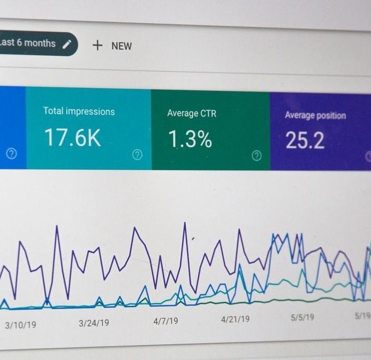If you're like most of us, you probably want a low bounce rate. It's simply one of the top-ranking factors in Google Analytics, and it's been that way for years. But what exactly is a bounce rate? And does it really matter to your small business?
We've put together this quick overview of bounce rates to help you understand how this metric works and why it matters for your business. We'll also share tips on reducing your bounce rate and improving your website's overall performance.
Why Bounce Rates Matter
For small business owners with online shops, it's essential to understand how bounce rates affect your business. A high bounce rate means that customers leave your site without purchasing anything, which means you miss out on sales. A low bounce rate means that visitors stay on your site and engage with it, which is good because they're more likely to convert into paying customers.
The website traffic that bounces is a sign that your site isn't engaging visitors, which means that it's probably not as effective at converting traffic into sales. The search results page is a great place to start when it comes to analyzing bounce rates.
If you’re ranking on page one for your target keywords, and your bounce rate is high, there’s likely something off with your site. You should also check out the landing page report in Google Analytics to see which pages are receiving the most traffic from organic search results. If those pages have high bounce rates, likely, people aren't finding what they want on your site.
You should also realize that other factors can affect your bounce rate, such as:
The length of your content.
How much value you provide on every page of your site.
How well-optimized each page is.
As you refine and optimize your site, you'll likely see a decrease in your bounce rate. That's good. It means people are spending more time engaged in sessions likely to result in conversions.
Tracking Bounce Rates
There are several ways to track your bounce rate and understand how it affects your site. You can use Google Analytics, which is free and has a useful dashboard that displays all kinds of metrics. Google Analytics is also a great way to get an overall picture of your site, including how many people visit it and what they're doing there.
You can also use Google Search Console to monitor your website's performance across multiple marketing channels to see where people find your site, how they arrive at it, and how long they stay there. Paired with Google Analytics, Search Console can give you a comprehensive picture of your site's performance and help you identify any issues that might impact it.
What Causes High Bounce Rates?
There are numerous reasons why people might bounce from your site. Some of them are easy to fix, while others may require more work. When people leave too quickly after visiting your website, it's a sign that something is wrong with your design or content. That could be due to:
Poor quality content that is not relevant to your audience.
A design that's confusing or difficult to navigate.
Irrelevant or outdated information on the site.
In other words, it's not enough to have great content; it has to be relevant, useful, and up-to-date. Optimization is the way to do that.
Optimizing Your Website for Low Bounce Rates
If you want to improve your website's bounce rate and make sure that visitors don't leave immediately after landing on your page, you need to optimize it for speed. The faster your page loads, the more likely visitors will stick around and engage with it. Site speed is one of the most critical factors in website analytics, and it can significantly impact your bounce rate.
To test your site speed, run an audit with Pingdom or use Google's PageSpeed Insights tool. These tools will analyze all aspects of your site — including its size, load time, and mobile friendliness — to give you actionable recommendations on improving it. They also offer detailed information about how each recommendation would affect your bounce rate.
Remember that every marketing channel has its own unique traffic patterns, so it's critical to optimize each one individually. Consider where your customers are coming from — what websites they visit before landing on yours. How long does it take for them to complete a task? These are key performance indicators (KPIs) you can use to focus your efforts.
Optimizing Website Content for Bounce Rates
Content optimization is an ongoing process, but it’s crucial to keep people on your website. You can start by analyzing your bounce rate and identifying what content works best for visitors. For example, well-written blog posts that provide value to your audience will keep people on your website longer. They’ll also serve as a source of authority for Google, which can help improve rankings for other pages on your website.
Creating more engaging sessions and lowering bounce rates is a matter of content optimization. You can start by:
Researching keywords that people are searching for in your industry.
Creating well-written content that resonates with your audience.
Including a call-to-action at the end of your content.
Creating content that encourages people to share it with others.
Using social media to promote your content and engage with your audience.
Your landing page, in particular, needs to be optimized to encourage visitors to act. That means using clear, concise headlines, subheaders, and convincing copy that addresses your visitors’ pain points.
It’s also important to keep in mind the goals of your landing page, which can vary depending on what you’re trying to accomplish. If you want visitors to sign up for an email list, then make sure there is no barrier between them and signing up. Don’t ask for too much information upfront, but keep things as simple as possible.
Get Those Bounce Rates Down
At the end of the day, bounce rate is simply a measure of the number of single-page visits your site receives. Tracking this metric is particularly useful for businesses that use their website to generate leads and then use other tools to follow up on these leads. If you can get your bounce rate down, your clients are more likely to follow through with an actionable next step, like making a purchase from your site or contacting you for more information.
At Scorpion, we have experimented with many factors that have helped us reduce bounce rates. We work hard to help our clients understand their audience and create a user experience that keeps visitors engaged.



[1].2111290913560.jpg)


